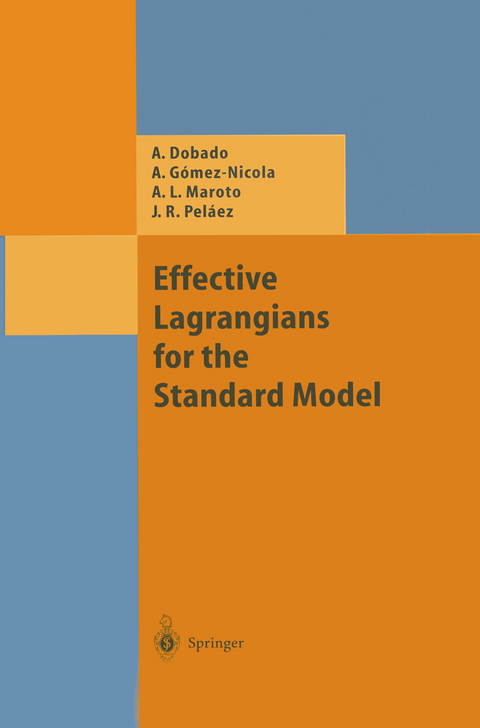
Effective Lagrangians for the Standard Model
Springer Berlin (Verlag)
978-3-642-63889-3 (ISBN)
1. The Notion of Effective Lagrangian.- 1.1 Introduction.- 1.2 Integration of the Heavy Modes.- 1.3 The Decoupling Theorem.- 1.4 The Euler-Heisenberg Lagrangian.- 1.5 Theories with Spontaneous Symmetry Breaking.- 1.6 Decoupling of Chiral Fermions.- 1.7 References.- 2. Global Symmetries in Quantum Field Theory.- 2.1 Classical Symmetries.- 2.2 Green Functions and the Reduction Formula.- 2.3 Quantum Symmetries and Ward Identities.- 2.4 Spontaneous Symmetry Breaking and the Goldstone Theorem.- 2.5 Explicit Symmetry Breaking and the Dashen Conditions.- 2.6 References.- 3. The Non-linear ? Model.- 3.1 Introduction.- 3.2 The Geometry and the Dynamics of the Non-linear ? Model.- 3.3 The Quantum Non-linear ? Model.- 3.4 Reparametrization Invariance of the S-Matrix Elements.- 3.5 Local Symmetries and the Higgs Mechanism.- 3.6 Topologically Non-trivial Configurations.- 3.7 References.- 4. Anomalies.- 4.1 Introduction.- 4.2 The Axial Anomaly, Triangle Diagrams and the ?0 Decay.- 4.3 The Axial Anomaly and the Index Theorem.- 4.4 Gauge Anomalies.- 4.5 Regularization Methods.- 4.6 Ambiguities and Counterterms.- 4.7 Topological Interpretation of Non-Abelian Anomalies.- 4.8 Non-perturbative Anomalies.- 4.9 Non-linear ? Model Anomalies.- 4.10 The Wess-Zumino-Witten Term.- 4.11 The Trace Anomaly.- 4.12 References.- 5. The Symmetries of the Standard Model.- 5.1 The Elements of the Standard Model.- 5.2 The Cabibbo-Kobayashi-Maskawa Matrix and Weak CP Violation.- 5.3 The Cancellation of Gauge Anomalies in the Standard Model.- 5.4 Baryon and Lepton Number Anomalies in the Standard Model.- 5.5 The Evolution of the Coupling Constants.- 5.6 The Strong CP Problem.- 5.7 The Symmetries of the Standard Model.- 5.8 References.- 6. The Effective Lagrangian for QCD.- 6.1 The QCD Lagrangian.- 6.2QCD at Low Energies.- 6.3 The Chiral Lagrangian at Leading Order.- 6.4 The Chiral Lagrangian to Next to Leading Order.- 6.5 The Low-Energy Constants.- 6.6 The Problem of Unitarity in ChPT.- 6.7 References.- 7. The Standard Model Symmetry Breaking Sector.- 7.1 The Mass Problem.- 7.2 The Effective Lagrangian for the SM Symmetry Breaking Sector.- 7.3 The O(p4) Lagrangian and One-Loop Renormalization.- 7.4 The Heavy Higgs and QCD-Like Models.- 7.5 Phenomenological Determination of the Chiral Parameters.- 7.6 The Equivalence Theorem.- 7.7 The Applicability of the Equivalence Theorem.- 7.8 Gauge Boson Scattering at High Energies.- 7.9 References.- 8. Gravity and the Standard Model.- 8.1 Introduction.- 8.2 The Standard Model in Curved Space-Time.- 8.3 Anomalies in the Standard Model.- 8.4 The Effect of Matter Fields on Gravitation.- 8.5 The Effective Action for Gravity.- 8.6 References.- A. Useful Formulae and Notation.- B. Notes on Differential Geometry.- C. Aspects of Quantum Field Theory.- D. Unitarity and Partial Waves.
| Erscheint lt. Verlag | 3.10.2013 |
|---|---|
| Reihe/Serie | Theoretical and Mathematical Physics |
| Zusatzinfo | XII, 316 p. |
| Verlagsort | Berlin |
| Sprache | englisch |
| Maße | 155 x 235 mm |
| Gewicht | 504 g |
| Themenwelt | Naturwissenschaften ► Physik / Astronomie ► Atom- / Kern- / Molekularphysik |
| Naturwissenschaften ► Physik / Astronomie ► Hochenergiephysik / Teilchenphysik | |
| Naturwissenschaften ► Physik / Astronomie ► Quantenphysik | |
| Naturwissenschaften ► Physik / Astronomie ► Theoretische Physik | |
| Schlagworte | Baryon • Boson • Differential Geometry • Field Theory • Geometry • Gravity • Lepton • Quantum Chromodynamics • quantum field theory • Quantum Gravity • standard model |
| ISBN-10 | 3-642-63889-9 / 3642638899 |
| ISBN-13 | 978-3-642-63889-3 / 9783642638893 |
| Zustand | Neuware |
| Haben Sie eine Frage zum Produkt? |
aus dem Bereich


